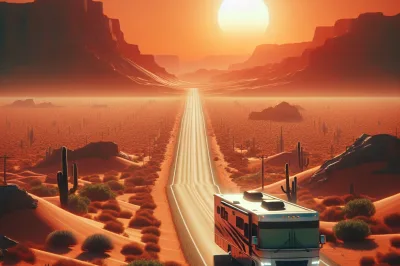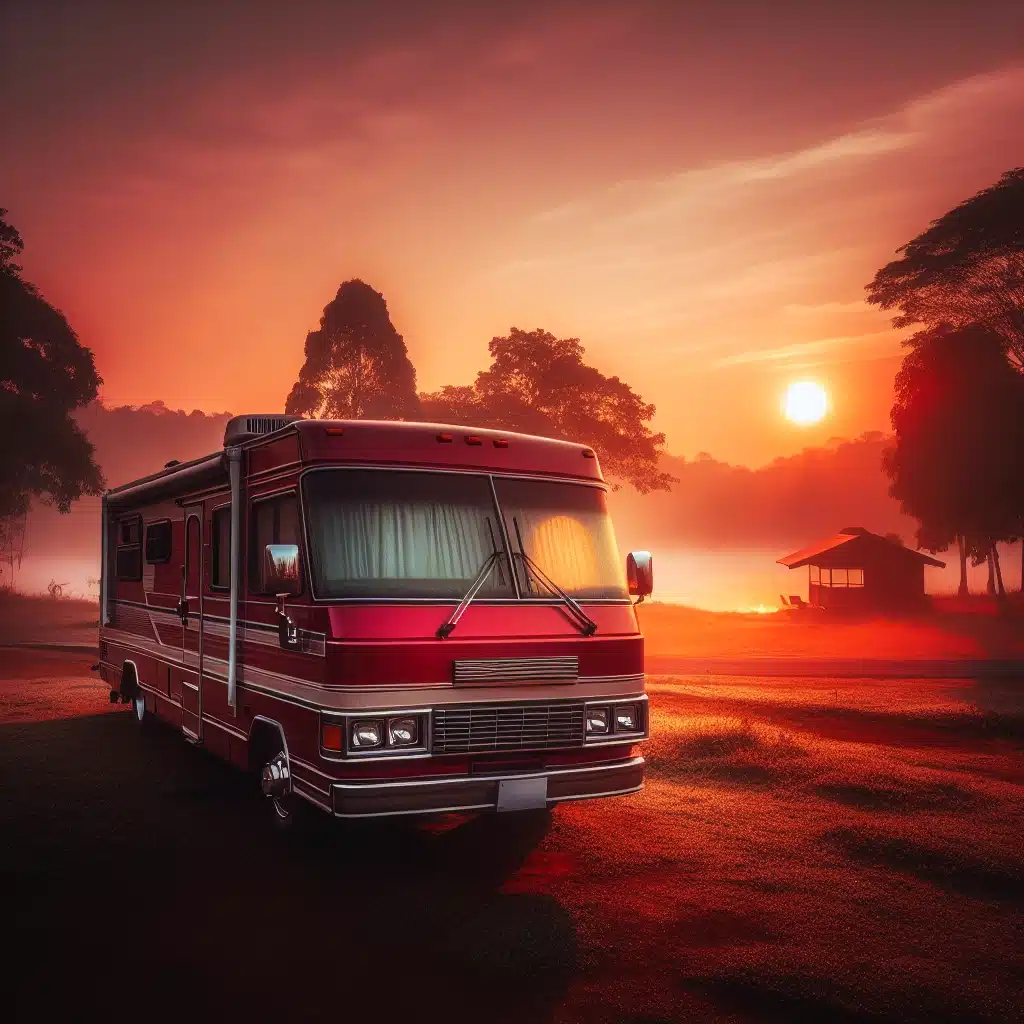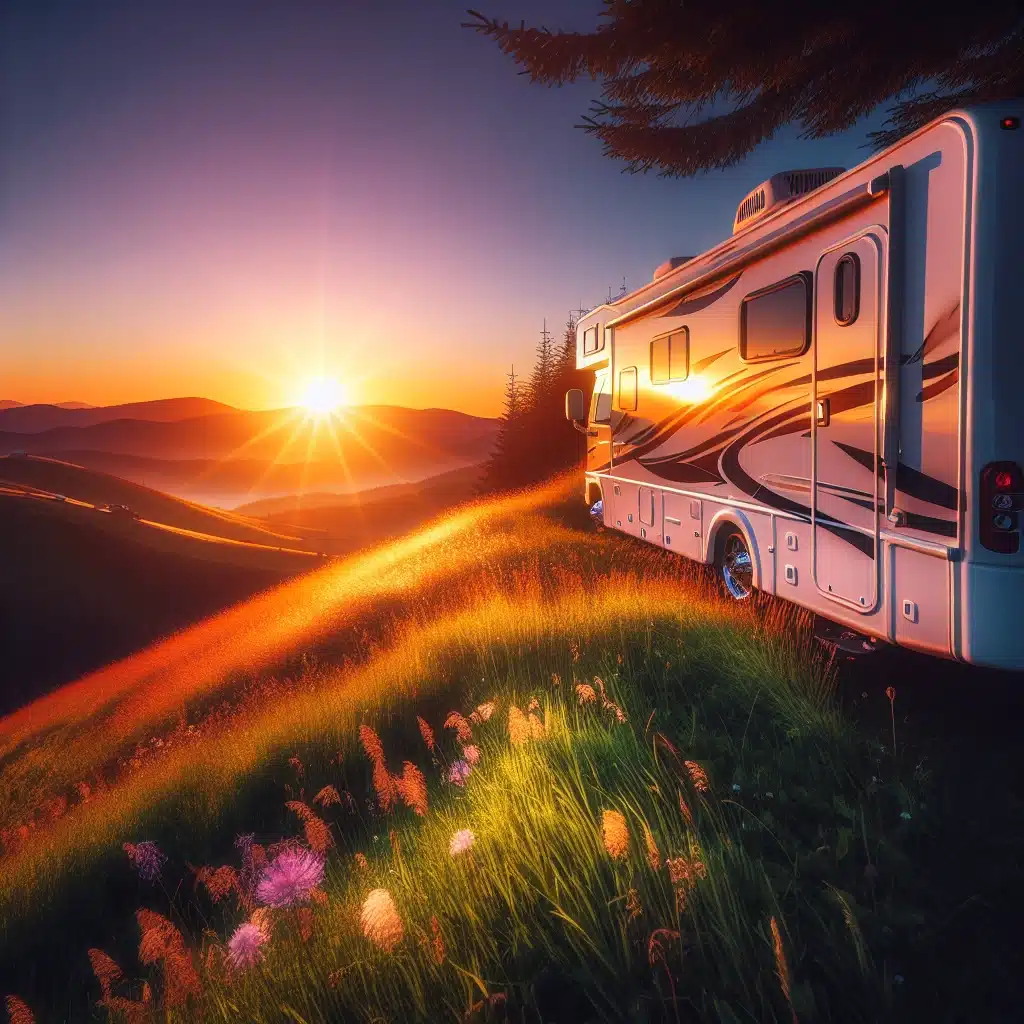Table of Contents

Embracing the Sun: Your Guide to Solar-Powered RV Freedom
Welcome to the world of solar-powered RV living, where the freedom of the open road meets the independence of off-grid living. If you’re looking to unplug from the matrix of campsite hookups and revel in the boundless landscapes only accessible to the self-sufficient, you’re in the right place. Let’s embark on this journey to harness the power of the sun for your RV, turning every sunrise into a promise of adventure.
Article-at-a-Glance
- Understand why solar power is the ultimate game-changer for full-time RV boondocking.
- Learn the essentials of a solar power setup for your RV.
- Discover how to calculate your power needs to ensure you never run out of juice.
- Find out how to choose the right solar panels for your specific RV lifestyle.
- Explore battery options for efficient energy storage and use.
Why Solar: The Heart of Off-Grid RVing
Imagine waking up to a serene sunrise, your coffee pot humming along, all while nestled in the heart of nature—no power lines in sight. This is the reality for RVers who’ve tapped into the power of solar. Solar energy is clean, quiet, and abundant, especially in the wide-open spaces where boondockers roam. It’s not just about saving on campground fees; it’s about sustainable travel and the peace that comes with self-reliance.
With solar panels on your RV, you’re no longer tethered to the grid. You can explore remote areas without the worry of running out of power. Solar power also means maintenance-free energy once your system is set up, and it’s better for the environment, reducing your carbon footprint as you travel.
But perhaps the most compelling reason to go solar is the sense of freedom it provides. You decide where to go and how long to stay, all while the sun quietly powers your home on wheels. It’s a liberating feeling, knowing that as long as the sun rises, you have the energy you need to live comfortably.
The Solar Setup: What You Need for Energy Independence
- Solar Panels: The face of your solar setup, these are responsible for capturing sunlight and converting it into electricity.
- Charge Controller: A vital component that regulates the voltage and current coming from your solar panels.
- Batteries: Where you’ll store the energy collected by your panels for use when the sun isn’t shining.
- Inverter: This device converts the stored DC power from your batteries into AC power for your RV’s standard electrical outlets.
- Mounting Hardware and Wiring: The nuts and bolts that hold your system together and transport energy where it’s needed.
Calculating Your Power Needs
Before you can bask in the sun’s glory, you need to know how much power you’ll actually use. Start by making a list of all your electronic devices and appliances. Then, jot down how many watts each item uses and how long you use them each day. Add it all up, and you’ve got your daily watt-hour total. Remember, it’s better to overestimate a little to avoid being caught short.
For example, if your laptop uses 60 watts and you use it for 5 hours a day, that’s 300 watt-hours per day just for the laptop. Repeat this for every device, and you’ll have a clear picture of your energy needs.
Pro Tip: Always factor in a bit extra for efficiency losses and those just-in-case moments. It’s better to have a little too much power than not enough.
Choosing the Right Solar Panels
Not all solar panels are created equal. You’ll find options like monocrystalline, polycrystalline, and thin-film, each with their own pros and cons. Monocrystalline panels are highly efficient and space-saving, making them a popular choice for RVs where roof real estate is precious.
When selecting panels, consider your RV’s roof size, your travel destinations (some areas receive more sunlight than others), and the balance between efficiency and cost. You want panels that will give you the most bang for your buck and fit your specific needs.
Batteries to Store the Sunshine
The sun isn’t always shining, but your need for power is constant. That’s where batteries come in. They store the energy your panels collect during the day for use at night or during cloudy weather. There are several types of batteries to choose from, including lead-acid, AGM, and lithium-ion.
Lithium-ion batteries are the gold standard for RV solar power systems due to their long lifespan, high efficiency, and low maintenance. They’re also lighter and more compact than their lead-acid counterparts, which is a big plus in an RV setting.
When sizing your battery bank, aim for enough capacity to get you through a couple of days without sun. This will give you peace of mind and plenty of power to keep the lights on and your devices charged, no matter the weather.
Charge Controllers: Protecting Your Investment
Think of a charge controller as your solar power system’s security guard. It stands between your solar panels and your batteries, ensuring that the power flowing into your batteries does so at a safe rate. Without a charge controller, your batteries could overcharge during sunny periods or drain too much during cloudy days, both of which can shorten their lifespan.
There are two main types of charge controllers: PWM (Pulse Width Modulation) and MPPT (Maximum Power Point Tracking). MPPT controllers are more efficient, especially in varied weather conditions, but they come with a higher price tag. Your choice will depend on your budget and the size of your solar array.
Remember, a good charge controller not only protects your batteries but also maximizes the efficiency of your solar setup. It’s a crucial component that’s worth investing in.
Inverters: Turning Sun into Service
Inverters are the magicians of your solar power system, transforming the DC electricity from your solar panels and batteries into the AC electricity that powers most of your RV’s appliances. When choosing an inverter, consider the total wattage of the appliances you’ll be running simultaneously and select an inverter that can handle that load.
There are two main types of inverters: modified sine wave and pure sine wave. Pure sine wave inverters are more expensive but provide cleaner power that’s similar to what you get from the grid, making them better for sensitive electronics like laptops and TVs.
Installing an inverter isn’t just about plugging it in; it’s about ensuring it’s accessible for maintenance, properly ventilated, and safely wired into your system. A well-installed inverter will serve you reliably, keeping your RV powered up wherever you roam.

Getting Started with Installation
Installation might seem daunting, but with the right tools and a bit of know-how, you can set up your solar power system. If you’re not comfortable with electrical work, it’s wise to consult a professional. However, for those ready for a DIY challenge, let’s walk through the key steps.
Mounting Solar Panels: A Step-by-Step Guide
First, you’ll need to decide where to place your panels. Look for a spot on your RV’s roof with maximum exposure to sunlight and minimal shading from trees or other structures. Once you’ve found the perfect location, it’s time to get to work.
- Measure and mark the area where each panel will go.
- Apply sealant to the underside of the mounting brackets to prevent leaks.
- Secure the brackets to the roof, taking care to not over-tighten and damage the roof material.
- Attach the solar panels to the brackets, ensuring they’re snug and secure.
- Connect the panels to each other, if you’re using more than one, and to the charge controller.
Take your time with this step. Properly mounted panels will withstand the rigors of the road and provide years of trouble-free energy.
Wiring for Efficiency and Safety
Wiring is a critical part of your solar power system. Use high-quality wires and connectors to minimize power loss and ensure safety. The wires from your solar panels will connect to the charge controller, and from there, to the batteries and inverter. Make sure all connections are tight and protected from the elements.
- Use the correct gauge of wire for the amount of current you’ll be carrying.
- Install fuses or breakers for added safety against electrical fires.
- Keep wires neat and organized to prevent damage and ensure easy maintenance.
- Consider using conduit or wire covers to protect against the weather and UV damage.
Remember, good wiring practices are not just about function; they’re about keeping you and your RV safe.
Setting Up Your Charge Controller
Now that your panels are mounted and wired, it’s time to set up your charge controller. Mount it in a convenient location, close to the batteries but in a spot with good ventilation. Connect the wires from your solar panels to the input terminals on the controller, and then connect the controller to your batteries.
- Follow the manufacturer’s instructions for the proper wire connections.
- Set the charge controller to the type of batteries you have to ensure correct charging.
- Ensure the controller is easily accessible for monitoring and adjustments.
A correctly set up charge controller will efficiently manage the flow of power to your batteries, maximizing their lifespan and your energy independence.
Battery Bank Configuration
Your battery bank is where you’ll store the power for use when the sun isn’t shining. The configuration of your battery bank—how you connect multiple batteries together—can affect the voltage and capacity of your system.
For a 12-volt system, you’ll typically connect your batteries in parallel, which increases capacity while maintaining the same voltage. For higher voltage systems, you might connect in series, which increases voltage but keeps capacity the same.
Pro Tip: Use identical batteries for your bank to ensure balanced charging and discharging. Mixing different types, ages, or brands of batteries can lead to inefficiency and reduced lifespan.
Take the time to get your battery bank configuration right. It’s the foundation of your solar power system and the key to consistent, reliable power on your boondocking adventures.
Inverter Installation Tips
When it comes to inverters, placement and installation are as crucial as the device itself. You’ll want to install your inverter in a location that’s close to your batteries to minimize voltage drop but also somewhere that’s cool and well-ventilated to prevent overheating. Ensure that it’s easily accessible for maintenance or troubleshooting.
- Mount the inverter on a sturdy surface to reduce vibration during travel.
- Use heavy-duty cables for connections to handle the high current flow.
- Ensure all connections are tight and secure to prevent arcing and potential fire hazards.
- Install a disconnect switch between the inverter and the battery bank for safety.
- Check the inverter’s manual for specific installation instructions and safety guidelines.
With the right setup, your inverter will efficiently convert DC to AC power, keeping your RV’s interior humming with the comforts of home.
Maximizing Solar Efficiency
Getting the most out of your solar panels isn’t just about having them—it’s about optimizing their performance. Every drop of sunlight is precious, and with a few smart strategies, you can squeeze out every bit of power from your panels.
Positioning Panels for Optimal Sun Exposure
Panel placement is paramount. Ideally, solar panels should face true south in the Northern Hemisphere to capture the most sunlight throughout the day. If your RV setup allows, adjust the tilt of your panels with the changing seasons—higher in winter when the sun is lower in the sky and lower in summer when it’s higher.
- Use a solar pathfinder or app to determine the best position for your panels.
- Avoid shading from trees, vents, or other obstructions as much as possible.
- Consider adjustable mounts that allow you to change the angle of your panels as needed.
- Clean your panels regularly to remove dirt, leaves, or snow that can block sunlight.
Remember, even a small shadow can significantly reduce the output of your solar panels, so keep them as unobstructed as possible.
Maintenance Routines to Boost Performance
Maintenance is the key to longevity and efficiency. Regularly inspect your solar power system to ensure everything is in top working order. Check for loose connections, frayed wires, and signs of corrosion. Keep an eye on your battery water levels if you’re using lead-acid batteries, and make sure your batteries are charged regularly to avoid sulfation.
- Clean your solar panels with a soft cloth and soapy water to remove any debris.
- Tighten any loose connections and replace worn or damaged components promptly.
- Use a multimeter to check the voltage and current of your system to ensure it’s operating within expected ranges.
- Keep a log of your system’s performance to spot any potential issues early.
A well-maintained system not only performs better but also prevents unexpected breakdowns that could leave you without power when you need it most.
Monitoring Systems to Track Energy Use
Knowledge is power, especially when it comes to managing your solar system. A monitoring system allows you to keep tabs on how much energy you’re producing and consuming. This insight helps you make informed decisions about your energy use and can alert you to potential issues before they become problems.
- Choose a monitoring system that provides real-time data on your energy production and consumption.
- Look for features like historical data tracking, which can help you plan your energy use over time.
- Consider systems that allow remote monitoring so you can check on your RV’s power situation even when you’re away.
- Ensure the system is compatible with your charge controller and inverter for seamless integration.
By keeping a close eye on your energy, you can adjust your usage to prevent draining your batteries and ensure a constant supply of power.

Life with Solar: The Full-Time Boondocker’s Experience
Transitioning to a solar-powered RV lifestyle is not just about the technical setup; it’s a change in the way you live and travel. Those who have made the switch find it incredibly rewarding, but it does come with its own set of challenges and adaptations.
Adapting to Solar-Powered Living
Adapting to life with solar means becoming more energy-conscious. You learn to appreciate the sun’s cycles and how weather patterns affect your daily power generation. It’s about understanding that energy is not unlimited and that you must manage your consumption to match your production.
- Use energy-efficient appliances and LED lighting to reduce your power draw.
- Charge laptops, phones, and other devices during peak sunlight hours.
- Develop a routine that takes advantage of natural light and warmth to minimize your energy needs.
- Be mindful of your energy usage and adjust your habits—like running the air conditioner or microwave—based on your available power.
Embracing solar power means embracing a lifestyle that’s in tune with nature. It’s about enjoying the silence of the wilderness without the hum of a generator, and the satisfaction of knowing that your home on wheels is powered by the clean, green energy of the sun.
Managing Energy: Smart Habits for Sustainable RV Life
Living the solar RV life is as much about managing energy as it is about enjoying the freedom it brings. It’s about making smart choices that stretch your stored power further. For instance, using natural ventilation instead of air conditioning, or cooking with a propane stove rather than an electric one can make a big difference. It’s these small, daily decisions that add up to a sustainable off-grid lifestyle.
- Turn off lights and appliances when not in use, just like you would at home.
- Invest in energy-efficient gadgets designed for low power consumption.
- Monitor your energy usage with a system monitor to avoid surprises.
- Plan high-energy activities, like laundry or vacuuming, for sunny days when your batteries are likely to be fully charged.
- Consider using a solar oven or cooking over a fire to save energy for other uses.
- Insulate your RV to maintain comfortable temperatures with less energy.
These habits not only conserve energy but also extend the life of your solar power system, ensuring that you can enjoy the boondocking lifestyle for years to come.
Backup Options for Extended Cloud Coverage
Even the most efficient solar power system can be challenged by a string of cloudy days. That’s why having a backup plan is essential. A portable generator can be a good friend during extended overcast weather, providing the necessary power to recharge your batteries without needing to relocate.
Another option is to install a high-capacity battery bank that can hold several days’ worth of power. This way, you can ride out the cloudy days without worry. Alternatively, consider a secondary charging source, like a wind turbine, which can complement your solar setup and provide power during less sunny periods.
Remember, the goal is to have a reliable power supply, no matter what the weather throws at you.
Upgrades and Enhancements for Your Solar System
As you spend more time on the road, you might find that your energy needs evolve. Maybe you’ve added a new gadget to your collection, or you’re spending more time in locations with less sunlight. Whatever the reason, there are several ways to upgrade and enhance your solar system to meet your growing needs.
Expanding Your Battery Capacity
If you find yourself frequently running low on power, it may be time to expand your battery bank. Adding more batteries can provide that extra cushion of stored energy to get you through longer nights or cloudy days. Just remember to match the type and age of your new batteries with your existing ones to maintain balance and efficiency.
When expanding your battery capacity, also consider upgrading your charge controller to handle the increased load. This will ensure your system continues to operate smoothly and efficiently.
Adding More Panels: When and How
Another way to boost your solar power system is by adding more solar panels. This can be especially helpful if you’ve increased your energy usage or if your existing panels aren’t quite meeting your needs. When adding panels, make sure they’re the same type as your existing ones to ensure compatibility.
Here’s what to keep in mind when expanding your solar array:
- Check your roof space to see if it can accommodate more panels.
- Consider the weight of additional panels and the impact on your RV’s balance and fuel efficiency.
- Upgrade your charge controller and inverter if necessary to handle the increased power output.
- Ensure your mounting system is robust enough to secure the additional panels.
With more panels capturing sunlight, you’ll generate more power, giving you greater freedom and flexibility in your travels.
Latest Trends in RV Solar Technology
The solar industry is constantly evolving, and staying informed about the latest trends can help you make the most of your system. Flexible solar panels, for example, are gaining popularity among RVers due to their lightweight design and ease of installation. They can be affixed directly to the roof of your RV, conforming to its shape and reducing wind resistance.
Another trend is the integration of smart technology into solar systems. With smart solar charge controllers and inverters, you can now monitor and manage your system from your smartphone or tablet. This technology provides valuable insights into your energy usage and system performance, allowing you to make adjustments on the fly.
As solar technology advances, the efficiency of solar panels continues to improve, meaning you can get more power from the same amount of space. This is great news for RVers looking to maximize their energy production without sacrificing valuable roof real estate.
FAQ: Harnessing the Power of the Sun
Got questions about going solar with your RV? You’re not alone. Here are some of the most common queries RVers have when considering the switch to solar power.
How much solar power do I need to run an RV?
The amount of solar power you need depends on your energy usage. Start by calculating the watt-hours you use each day, then size your solar array to meet or exceed that amount. Keep in mind that solar panels don’t produce at their maximum capacity all day, so it’s wise to have a little extra to cover your needs.
Can I install a solar power system in my RV myself?
Yes, with some electrical knowledge and the right tools, you can install a solar power system yourself. However, if you’re not confident in your abilities, it’s best to hire a professional to ensure everything is set up safely and correctly.
How do I maintain my RV solar power system?
Maintenance is relatively straightforward. Keep your solar panels clean, check your battery water levels if using lead-acid batteries, and inspect your system regularly for loose connections or damaged components. A well-maintained system will serve you well for many years.
Is solar power enough for full-time RV boondocking?
For many, solar power is sufficient for full-time RV boondocking. The key is to accurately size your system based on your energy needs and to adapt your energy consumption habits. With a well-designed solar setup and efficient use of power, you can enjoy the freedom of living off-grid without sacrificing comfort.
What are the initial costs for setting up a solar-powered RV?
The initial costs can vary widely depending on the size and quality of your solar power system. A basic setup might start around a few thousand dollars, while a more robust system with high-efficiency panels and a large battery bank could run significantly higher. Consider it an investment in your freedom and self-sufficiency on the road.
In conclusion, transitioning to solar power for your RV is a rewarding decision that brings a new level of freedom to your travels. It allows you to explore the great outdoors with minimal environmental impact and provides a sustainable source of energy for your adventures. By understanding your power needs, choosing the right components, and maintaining your system, you can enjoy the benefits of solar power for years to come.
Remember, the sun is your limitless fuel source, and with solar panels on your RV, every day is an opportunity to generate clean, green energy. So, embrace the solar-powered lifestyle and hit the road with confidence, knowing you’re well-equipped for the journey ahead.
- Boondocking RVs: Flexible Solar Solutions – 3 March 2024
- Renewable Energy Tips for Full-Time Boondocking RVers – 2 March 2024
- Boondocking Solar Power Systems: Sizing Options & Solutions for Motorhomes – 1 March 2024
